#frederick adolf of sweden
Text
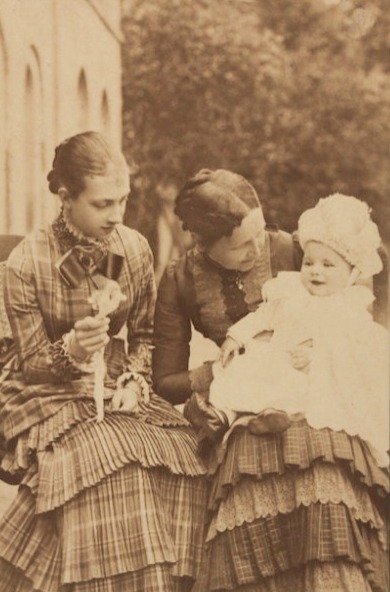
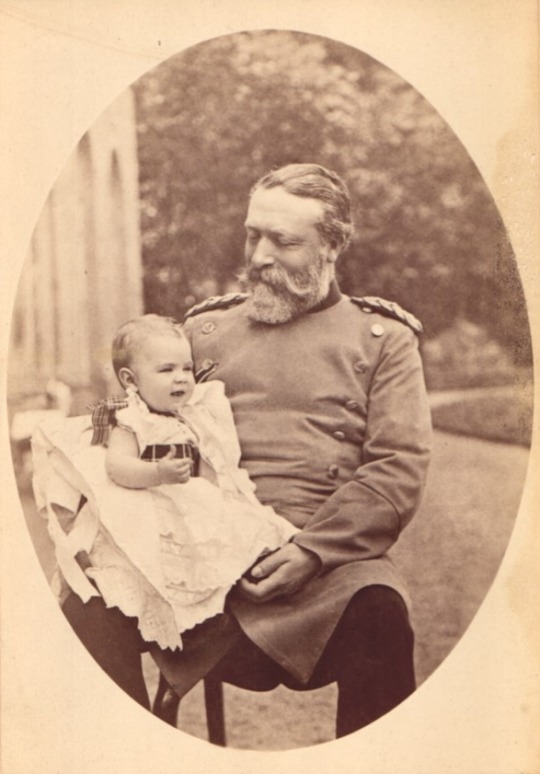


Baby Prince Gustaf Adolf of Sweden (King Gustaf Adolf VI) with his mother, Crown Princess Victoria of Sweden and maternal grandparents, Grand Duke Frederick I and Grand Duchess Louise of Baden, 1883.
#king gustaf vi adolf of sweden#grand duke frederick i of baden#grand duchess louise of baden#crown princess victoria of sweden#queen victoria of sweden#swedish royal family#baden#1883#1880s
39 notes
·
View notes
Text
youtube
Adolf Frederick of Sweden
14 May 1710 – 12 February 1771
DIED FFROM EATING TOO MUCH
Adolf Frederick, King of Sweden, was said to have died because he ate too much. He ate a large meal and 14 Semlas. Semlas are buns made from white flower with cream. They were served in a bowl of milk with cinnamon and raisins. He also ate caviar, lobster and a selection of meats. He also drank a lot of champagne.
The king suffered from gout, which his over-indulgence didn’t help.
He died aged 60, in Stockholm from digestive problems due to complications due to his digestive tract. It was said he died from heart failure or rumoured ‘poisoning’. The truth of his death could be propaganda, composed by modern writers.
Frederick ruled as king from 1751 to 1771. He was the son of Christian August of Holstein-Gottorp, Prince of Eutin and Albertina Frederica of Baden-Durloach. He was the uncle of Catherine the Great. He was a weak monarch, however his reign saw peace. After his death his son Gustav III gained power.
#adolffrederickofsweden #adolffrederickkingofsweden #horriblehistories #stupiddeaths
#adolf frederick of sweden#adolf frederick king of sweden#horrible histories#horriblehistories#stupid deaths#stupiddeaths#Youtube
0 notes
Text

The Crown of the Swedish Queen / The Queen's Crown
Queen Lovisa Ulrika's Crown from 1751 is the crown of the Swedish Queen. It was made by Swedish goldsmith Andreas Almgren to a design by architect Jean Eric Rehn. This differs from the other crowns, being entirely dominated by large brilliants.
On 26 November 1751, Sweden's new King and Queen – King Adolf Fredrik and Queen Lovisa Ulrika – were crowned at Stockholm Cathedral. Forty-four very large brilliants had been given to Lovisa Ulrika by the Swedish Riksdag on the occasion of her wedding in 1744. Before the coronation, these were incorporated into the new Queen's Crown.
The 1750s were a decade of political tension, mainly relating to how much power and influence the King should have on state affairs. The conflict between the King and the Riksdag all came to a head during the 1755 Riksdag; the monarch lost, and the Riksdag was given the right to use a name stamp with the King's name instead of having the King sign each decision made by the Riksdag.
The Queen, who had been born Princess of Prussia and was the sister of King Frederick the Great, could not accept the outcome of the 1755 Riksdag decision. The natural order of things, as she knew it, was for the monarch to be able to rule his country. For her, revolution was the only solution! But pulling off a coup d'etat cost money, which Queen Lovisa Ulrika needed to have at her disposal. Somehow, someone – or some people – close to the Queen managed to replace the 44 large brilliants in the Queen's Crown with rock crystal.
The brilliants were smuggled out of the country and pawned with an antiques dealer in Hamburg. The Queen and her close circle did not realise that this man was a secret agent of the French government. A government that frequently bribed leading Swedish politicians.
The German antiques dealer understood where these jewels had come from and immediately wrote to the French ambassador in Stockholm, informing him what had happened. The ambassador, in turn, notified the Riksdag, after which the attempted coup d'etat was thwarted before it had even started.
This was a particularly humiliating episode for the Royal Family. But the crown was restored to its original condition and is now a dazzling and unique example of 18th-century Swedish design, craftsmanship and politics.
Photo: The Royal Court of Sweden
#swedish royal family#queen silvia#queen lovisa ulrika#swedish crowns#swedish royalty#swedish history#coronation#crown#crowns#crown jewels
30 notes
·
View notes
Text
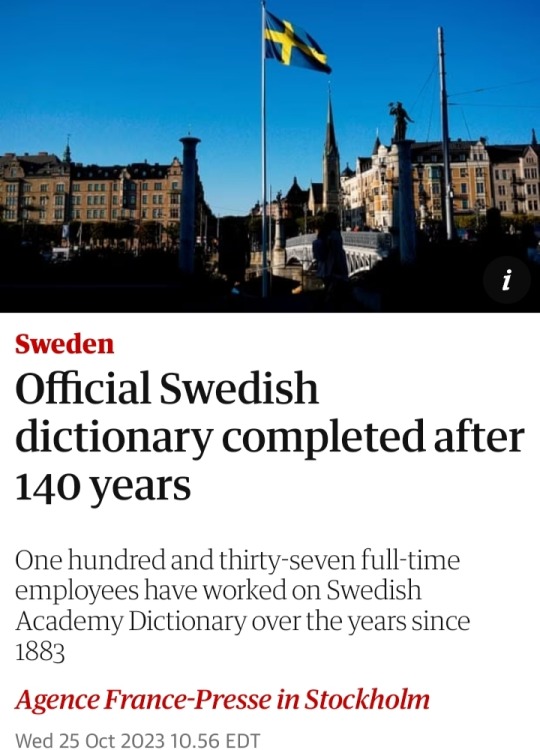
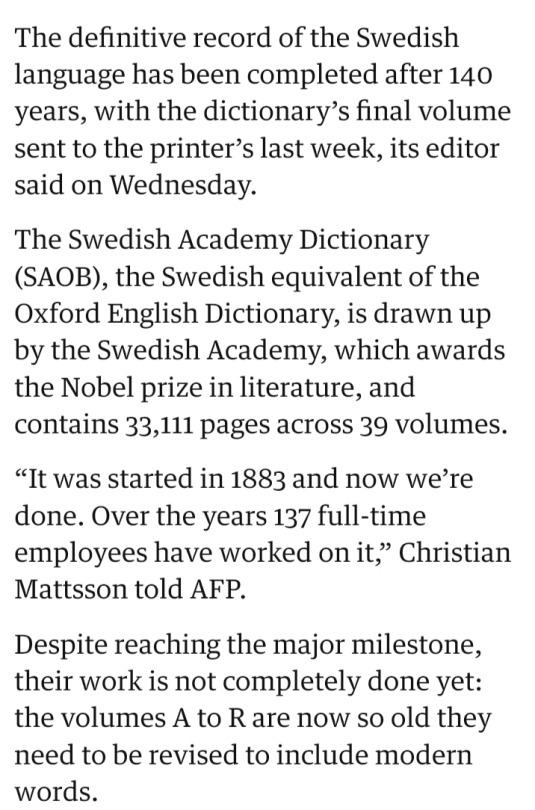



Gustav III (24 January [O.S. 13 January] 1746 – 29 March 1792), also called Gustavus III, was King of Sweden from 1771 until his assassination in 1792.
He was the eldest son of King Adolf Frederick and Queen Louisa Ulrika of Sweden.
#Swedish Academy Dictionary#Swedish Academy#Swedish language#SAOB#King Gustav III#dictionary#language#culture#words#Sweden
21 notes
·
View notes
Text

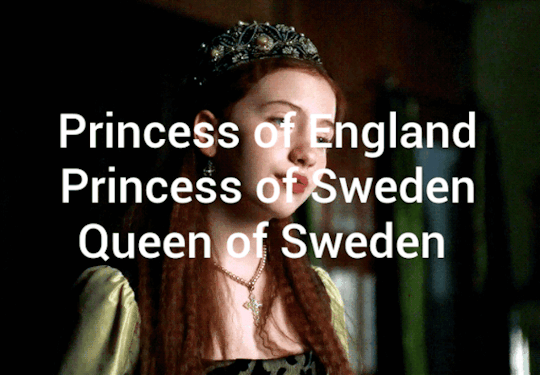

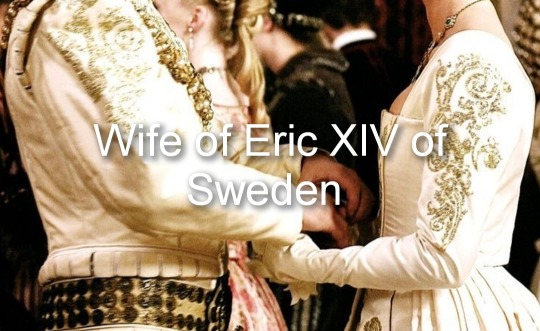

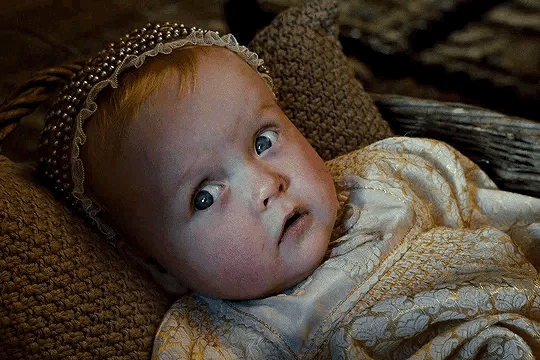
A happier life for Henry VIII's children. Part 2.
Elizabeth was the second daughter of King Henry VIII of England and his second wife Anne Boleyn. When the girl was 3 years old, the king annulled the marriage to her mother. Henry sent Anne to a convent and forbade Anne to communicate with her daughter, and soon afterward married Jane Seymour. She developed a close relationship with her stepmother, brother and sister. In 1547, her father died and Elizabeth was finally able to meet her mother. The meeting between mother and daughter after years of separation was very touching. When Anne saw Elizabeth, she could not believe that this beautiful girl was her daughter. First they cried for a long time in each other's arms, and then they sat up all night talking. They had a lot to say to each other. So their meetings became more and more frequent, and Edward allowed his father's second wife to stay with Elizabeth. In 1557 Edward VI began to look for worthy suitors from Protestant countries, for the hand of his sister, and his choice fell on the eldest son of the King of Sweden, Prince Eric. In the king's opinion, this marriage was to strengthen the sympathy of his subjects for him. In 1558, the princess became the wife of the heir to the Swedish crown, and 2 years later they became King and Queen of Sweden. It is said that at their first meeting the prince was so enchanted by her beauty that he lost the power of speech. Their married life was strong and passionate. For her husband Elizabeth became the most important confidante, with whom he discussed many problems. Six children were born in the marriage:
Gustav II of Sweden (1559 - 1605) Not interested in politics and never wanted to be king. Overthrown and killed by conspirators, including his own son Charles. Husband of Maria of Austria. Father of 4 children: Charles IX, Ludwig, Frederick, Elizabeth.
Anne of Sweden (1560 - 1634) Countess of East Friesland. At the age of 18 she married her cousin Enno III. The marriage was a happy one for both spouses. They became the parents of 9 children: Edzard III, Sabina, Agnes, Johann, Gustav, Rudolf, Christina, Sophia, Christian.
Magnus of Sweden(1561 - 1619) In 1582 he married his cousin Mary of England. They had 4 children: Nils, Katharina, Gunilla, Arnold. Magnus was widowed in 1590. And in 1592 he married his mistress Maria Oberg, but before that he received from his elder brother-king and his mother a permission to remarry. From his second wife he had 6 children: Magdalena, Sven, Hokon, Valdemar, Ingeborga, Svante.
Johan of Sweden(1565 - 1630) From childhood Johan was interested in navigation and discoveries. Therefore, he spent most of his life traveling, exploring lands not previously known. He was never married, however he recognized 3 children: Brita, Lars, Eric. And upon his death, he left each child a generous inheritance.
Cecily of Sweden(1567 - 1634) Macgravine of Baden-Rodemachern. In 1583 became the wife of Edward Fortunatus They became the parents of 5 children: Christoph III, Cecily, Elizabeth, Ottilia, Herman. In 1603, her husband died and Cecily was offered remarriage
Virginia of Sweden(1570 - 1606) Duchess of Holstein-Hottorp, wife of Johann Adolf. Virginia was older than her husband by 5 years, but despite this their marriage was happy. They had 7 children: Frederick III, Elisabeth, Conrad, Dorothea, Gedviga, Albrecht and Augusta. The Duchess died of childbirth fever a week after the birth of the last child. After the death of his wife, Johann lived the remaining 10 years until his death as a widower.
In 1568, the queen returned briefly to England for her mother's funeral. In 1577, King Eric XIV of Sweden died, and Elizabeth mourned her husband's death bitterly. But fortunately for Elizabeth, she had her children and grandchildren by her side, who became the meaning of her life. In addition, the Queen Dowager actively influenced the policies of her eldest son, King Gustav II. Gustav, weak-willed and indecisive, was not interested in ruling the state. In fact, the kingdom was ruled by Elizabeth, which did not please her daughter-in-law. Because of this, the two women often conflicted with each other. In March 1603, the Queen Dowager of Sweden died. She was buried in Uppsala Cathedral next to her husband. And 2 years later Gustav II was overthrown and killed. Her grandson Charles became the next king of Sweden.
Tumblr: History.Period Drama
#history#royal family#royalty#history au#au#royal#the tudors#henryviii#british royal family#anne boleyn#english history#tudors#elizabeth i#marytudor#edwardvi#jane seymour#catherine of aragon#britishmonarchy#royals#english royalty#the other boleyn girl#house of tudor#Tudor time
3 notes
·
View notes
Text
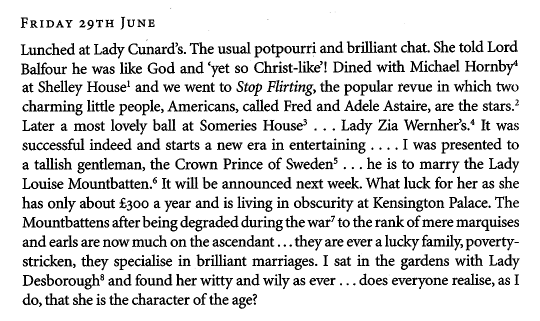
Henry ‘Chips’ Channon: The Diaries (Vol. 1), 1918-38, entry for 29th June 1923
—
Friday 29th June
Lunched at Lady Cunard’s. The usual potpourri and brilliant chat. She told Lord Balfour he was like God and ‘yet so Christ-like’! Dined with Michael Horby¹ at Shelley House² and we went to Stop Flirting, the popular revue in which two charming little people, Americans, called Fred and Adele Astaire, are the stars.³ Later a most lovely ball at Someries House⁴ ... Lady Zia Wernher’s.⁵ It was successful indeed and starts a new era in entertaining .... I was presented to a tallish gentleman, the Crown Prince of Sweden⁶ ... he is to marry the Lady Louise Mountbatten.⁷ It will be announced next week. What luck for her as she has only about £300 a year and is living in obscurity at Kensington Palace. The Mountbattens after being degraded during the war⁸ to the rank of mere marquises and earls are now much on the ascendant ... they are ever a lucky family, poverty-stricken, they specialise in brilliant marriages. I sat in the garden with Lady Desborough⁹ and found her witty and wily as ever ... does everyone realise, as I do, that she is the character of the age?
—
1. Michael Charles St John Hornby (1899-1987), son of St John Hornby, was the founding partner of WH Smith.
2. The Hornby family’s house in Chelsea.
3. Frederick Austerlitz (1899-1987), who took the name Fred Astaire, was an American actor, dancer and singer who achieved worldwide fame in the 1930s in a series of Hollywood musicals renowned for their dance routines; and his sister Adele Marie (1896-1981), with whom he began a vaudeville act as children as 1905, when they changed their name to Astaire. By 1923 they had a Broadway act, which they were touring in London.
4. A Crown State property rented by the Wernhers in Regent’s Park, designed by John Nash and damaged by bombing during the Second World War. It was demolished in 1958.
5. Countess Anastasia Mikhailovna of Torby (1892-1977), elder daughter of the Grand Duke Michael Mikhailovich of Russia, and therefore a great-granddaughter of Tsar Nicholas I. She married, in 1917, Harold Wernher (1893-1973), later 3rd Bt. She was granted the rank and precedence of an earl’s daughter after her marriage and stopped using her Russian title, being known as Lady Zia Wernher thereafter.
6. Oscar Fredrik Wilhelm Olaf Gustaf Adolf (1882-1973), from 1950 King Gustaf VI Adolf of Sweden. He was the widower of Princess Margaret of Connaught (1882-1920), whom he had married in 1905; she was the cousin of King George V, and had died suddenly while eight months pregnant with her sixth child.
7. Louise Alexandra Marie Irene Mountbatten (1889-1965), previously Princess Louise of Battenberg, married the Crown Prince of Sweden (vide supra) in 1923, and was Queen Consort of Sweden from 1950. She was daughter of Prince Louis of Battenberg, who became 1st Marquess of Milford Haven when renouncing the German titles in 1917. She had earlier turned down proposals from King Manuel II of Portugal and had been secretly engaged to Prince Christopher of Greece, who was unable to marry her because he had no money; a second engagement was to Stuart Hill, an artist, whom she met while nursing in the Great War and who turned out to be homosexual.
8. There was a protracted debate between Lloyd George, King George V and Lord Stamfordham, the King’s private secretary, in 1917 about the titles to be bestowed on German members of the King’s family who had pledged allegiance to him and had been prepared to forfeit their German ranks. The King was cautioned against granting too many titles and to avoid bestowing any dukedoms. The Mountbatten marquessate was a compromise and their rise would indeed be unstoppable, with the surname of members of the House of Windsor becoming Mountbatten-Windsor in 1960, thirteen years after the marriage of the future Queen Elizabeth II to Philip Mountbatten.
9. Ethel ‘Ettie’ Fane (1867-1952), married in 1887 William Henry Grenfell (1855-1945), 1st Baron Desborough, a former Liberal MP who had joined the Conservatives in 1893 over his disagreement with the second Home Rule Bill for Ireland. Their three sons (qqv) predeceased them, two killed in the Great War and a third in a car crash.
#chips channon#channon diaries#1923#1920s#emerald cunard#arthur balfour#michael hornby#fred astaire#adele astaire#zia wernher#gustaf vi adolf#louise mountbatten#ettie desborough#🕰️
7 notes
·
View notes
Photo

Anna Sophia "Sophie" Hagman, née Anna Kristina "Stina" Hagman (31 December 1758, in Eskilstuna, Södermanland, Sweden – 6 May 1826, in Stockholm, Sweden), was a Swedish ballet dancer. She was the official royal mistress to Prince Frederick Adolf of Sweden from 1778 to 1793.
#Sophie Hagman#Anna Sophia Hagman#Anna Kristina Hagman#women in art#women in ballet#women in history#XVIII century#XIX century#people#portrait#Illustration#art#arte
5 notes
·
View notes
Photo

Juliana of Hesse-Eschwege was described as a great beauty but there are no portraits of her. The portrait shown is of her mother.
Juliana was taken to the royal Swedish court to be brought up there as the future queen of Sweden by queen dowager Hedwig Eleonora of Holstein-Gottorp, with the prospect of being married to her cousin, Charles XI, when he reached adulthood.
These plans never came about. In 1672, during a carriage ride in Stockholm with the queen dowager, Juliana fell to the floor of the carriage in labour. The father of the child proved to be a married officer of the court, Count Gustaf Lillie. The count was exiled, and Juliana was sent to the country, where she was given her own estate and court. The child, a son, was named after his father, Gustaf Gustafsson Lillie, was later raised by Baron Gustaf Adolf von der Osten. His fate is unknown.
The estate Juliana was sent to was run by a Dutch housekeeper named Marchand, who was the widow of a grocer, and she had a son, Johan Jakob, with him. This would be the second time Juliana became pregnant out-of-wedlock. In 1679, Juliana's cousin, King Charles, gave her his permission to marry her lover, who was given the title Baron von Lilienburg. They married on 22 February 1680 in Sweden.
The couple moved far away from the Swedish court to the Netherlands, where Johan was offered a government position in IJsselstein by Stadtholder William III, who was distantly related to Juliana. The couple had eight children. Juliana died in IJsselstein in 1693, followed by Johan 1703.
I found Juliana interesting because her mother had a similar scandal to hers: After her wedding to Frederick, Landgrave of Hesse-Eschwege, Eleonora confessed before her husband, "on her knees", that she had had a six week affair with French lute-player Beschon, and was pregnant with his child. Frederick decided to act like nothing happened and hide the matter, but it became a known scandal.
Beschon wrote a composition to Eleonora which he sent her along with a letter dated 28 February 1647, but she gave it to her brother; these documents are now preserved in the Stegeborg collection.
#Eleonora Catherine of the Palatinate-Zweibrücken#Juliana of Hesse-Eschwege#swedish history#history#Frederick Landgrave of Hesse-Eschwege#Charles XI#Count Gustaf Lillie#scandals#scandal#history scandals
2 notes
·
View notes
Photo
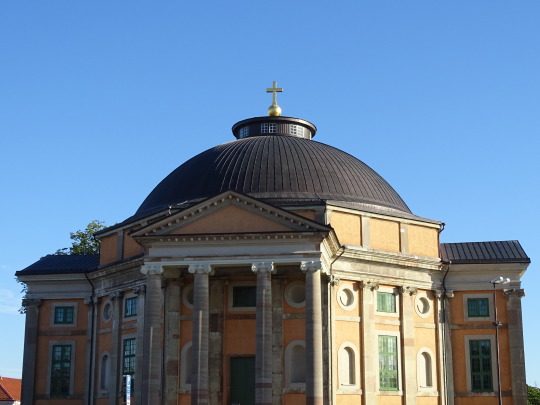
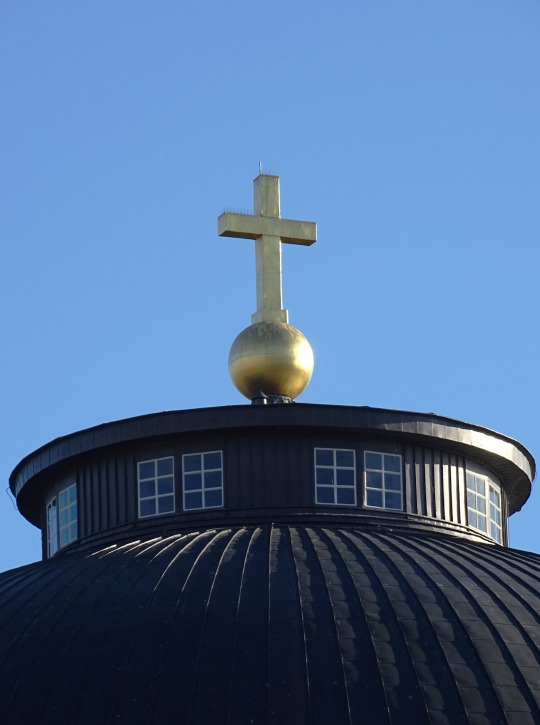
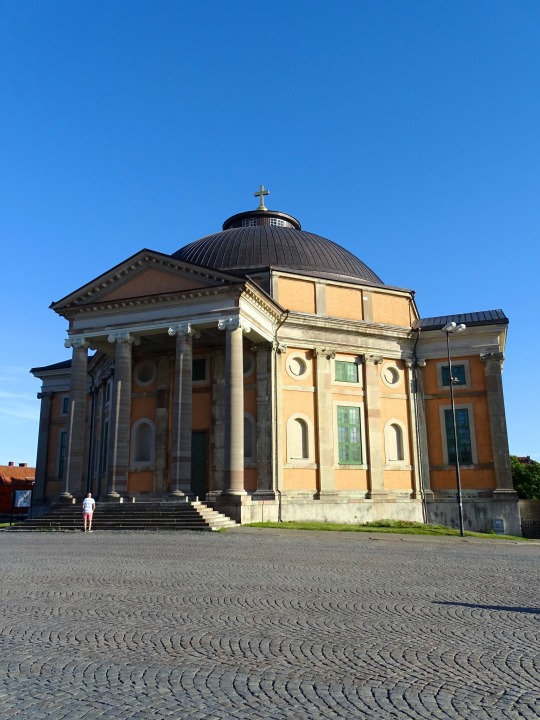

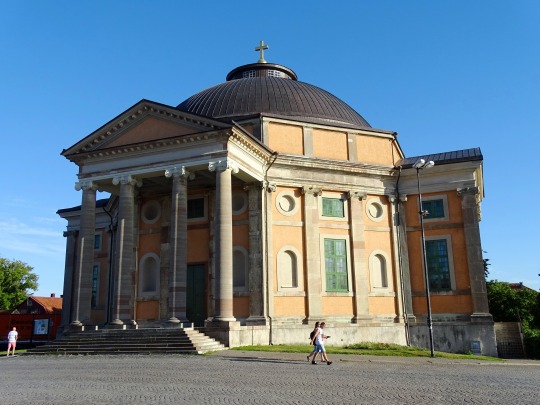


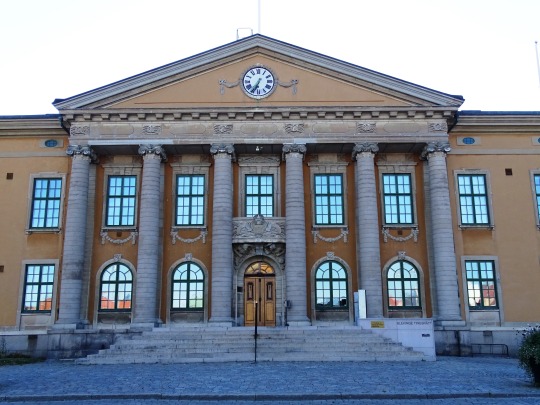


Karlskrona, Sweden (No. 9)
The Fredrik Church (Swedish: Fredrikskyrkan) is located in Karlskrona, Blekinge Län, southern Sweden. Situated on Stortorget, the main square in the city centre, The Fredrik Church is included within the Karlskrona UNESCO World Heritage Site.
Construction on the Fredrik Church began September 9, 1720 as a replacement for the city's temporary wooden church, Hedvig Eleonora Church. The Fredrik Church's first stone was laid by the then Governor Salomon von Otter, the foundation wall was completed on August 25, 1721, and the church was consecrated in 1744. Though Crown Prince Adolf Frederick was present for the event, the building was named in honor of Frederick I. The spires atop the church towers were completed in 1758.
There were several restorations. The one in 1805–06 was led by architect Olof Tempelman. Interior restorations occurred in 1913–15 under Axel Lindegren, and there was another in 1967–68. An exterior restoration occurred in 1997–98.
The Fredrik Church was built in the baroque style after a design by Nicodemus Tessin the Younger. Its towers are a notable feature. The carillon is housed in the south tower, and there are 35 bells, which were installed in 1967 by the Bergholtz Bellfoundry [sv]. The clock chimes three times a day.
Source: Wikipedia
The Trinity Church (Swedish: Trefaldighetskyrkan, alternate, "German Church") is located at Karlskrona in Blekinge, Sweden. Along with the Karlskrona Admiralty Church (Amiralitetskyrkan), the church is situated in the main square, (Stortorget), at the center of the island of Trossö.
The church was built in Baroque architecture for the town's German-speaking population. The first foundation stone was set in 1697. The church was inaugurated on June 27, 1709. The church was designed by architect Nicodemus Tessin the Younger 1654–1728). The structure includes a domed rotunda. At the time of the citywide fire in Karlskrona in 1790 the church burned and only the walls remained. The church was rebuilt after the original drawings.
After the fire in 1790, only the severely damaged outer walls remained. In 1791, architect Olof Tempelman (1745-1816) was commissioned to draw up proposals for the reconstruction of the church. His simplification of architectural details for the exterior of the church resulted in a building with Neoclassical architecture style. In 1802, the church was re-inauguration. In 1814, the church interior was completed. The principal responsible for this work was Admiralty sculptor Johan Törnström (1743-1828). Most notably he created both the altarpiece and pulpit for the Church.
The church was listed as part of the Naval Port of Karlskrona on the UNESCO World Heritage List in 1998.
Source: Wikipedia
#Stortorget#Fredrik Church#Trinity Church#Trefaldighetskyrkan#city hall#Fredrikskyrkan#architecture#Karlskrona#Blekinge County#Scandinavia#Sweden#Sverige#Northern Europe#summer 2020#cityscape#landmark#tourist attraction#old town#vacation#travel#sculpture#Charles XI by John Börjeson#public art#exterior
2 notes
·
View notes
Note
❤️🧡💛💚💙💜 If you get this, tell us three random things then send to three random blogs. ❤️🧡💛💚💙💜Love wins spread the love. 💗
I’m full of fun facts but I get an Ask like this and it all flies out of my head, but here we go!
1. At one point in Europe, there were at least three holy foreskins of Christ in three different church reliquaries.
2. King Adolf Frederick of Sweden ate himself to death after having an absurdly massive meal.
3. I’m a Pope Joan truther. There is a legend that a woman disguised herself as a man only to get found out when she gave birth on the streets of Rome. Oops. For all intents and purposes though, Pope Joan was actually pretty good at her job, which is more than I can say for most medieval popes. There was a ritual when taking the papacy where the pope sat on an ancient Roman toilet and got his balls felt to make sure they were there. Many attribute this ritual to the deception of Pope Joan, though the Catholic Church insists that she didn’t exist. (IMO she does partly because it’s funny and partly because parts of the story don’t make sense such as the fact that she did a good job, because if one woman can do it, then others might be able to gaslight, gatekeep, girlboss their way to the papacy
5 notes
·
View notes
Note
Falling out of bed – 450 people per year die after falling out of bed;
Randy Llanes impaled on the bill of a swordfish;
Falling off a ladder and landing head first in a water butt;
Man killed by his own explosive while trying to steal from a condom dispenser;
Hit by a coconut falling off a tree, approximately 150 people each year are killed by coconuts;
Man died after being stabbed in the eye with an umbrella;
Teenager taking a selfie with a loaded handgun shot himself in the throat;
US cyclist, Troy Earl Smith Jr, shot himself to death with gun carried in his breast pocket;
Man crushed while moving a fridge freezer;
Undertaker Marc Bourjade crushed by his own coffins
Crushed by your partner;
In 1975, Alex Mitchell laughed so hard at The Goodies ‘Ecky Thump‘ episode that he died of heart failure;
Man run over by his own vehicle;
Texan Michael Warner, 58, died of a lethal Sherry enema;
King Adolf Frederick of Sweden – the King who ate himself to death;
24 people each year are killed by champagne corks;
Strangled by neckties or scarves;
Barry Pilgrim trampled by cattle in the Derbyshire;
Peggye McNair and Mark Mere – trampled to death by camels on a farm;
Alexandru Pop, 46, eaten by a drove of pigs;
Spectator deaths – hit by golf ball, cricket ball, racing/rally car or motorcycle;
Suicidal man who threatened to kill himself with a knife is shot dead by police;
Roger Wallace was killed by his own remote controlled plane
Stepping backwards off cliff or similar to help photographer get you in frame;
Falling from the top of a lighthouse;
Falling off an inflatable artwork;
Falling into a water butt;
Drowning in a barrel of mead;
Drinking too much water;
Killed by an industrial firework placed on head;
Eating too many carrots;
Swung by your ankles by a clown and hitting your head – William Snyder of Cincinnati, Ohio, died age 13 in 1854;
Falling off a theatre balcony;
Hit by a piece of falling scaffolding;
Crushed by giant bale of hay falling on your van;
Hit by bullets fired in celebration;
Falling out of a tree;
Walking through a closed glass door and being cut to death;
Drowning in the bath;
Car engine bonnet shutting on your head;
Heading a medicine ball;
Stabbed during argument over game of Ludo;
Falling on to wine glass and cutting neck;
Kicked by a horse;
Burned to death while making a barbecue from an oil drum.
Dropping weights on yourself while doing presses.
Owner of the world’s longest beard tripped on it and broke his neck
American lawyer Clement Vallandigham shot himself in a court room in 1871 while showing the jury how his client’s alleged murder victim had actually shot himself;
Eight people were killed in the London Beer Flood of 1814, when 135,000 gallons of ale burst out of the Meux and Company Brewery on Tottenham Court Road;
Death by carrot juice overdose. Basil Brown drank 10 gallons of juice in 10 days – overdosing on Vitamin A and suffering severe liver damage.
Very interesting.
Couple of questions though, first one being who are you?, second one what the actual fuck??
0 notes
Note
Yes they are first cousins, they share the grandparents Gustaf VI Adolf of Sweden and his first wife Princess Margaret of Connaught, a granddaughter of Queen Victoria and Prince Albert. The Swedish King’s father was their eldest son Gustaf Adolf, who died when our current king one 1 year old. Their only daughter, Ingrid, married Frederick who became Frederick IX of Denmark, thus becoming Queen Ingrid of Denmark. She lived until the year 2000.
As Frederick and Ingrid had three daughters, Denmark changed their law of succession so that Margrethe could inherit the throne. I think she went on a state visit to Sweden in her first year as Queen in 1972-73, visiting her grandfather Gustaf VI Adolf, their reigns overlapped by one year. Sweden was still very old fashioned under Gustaf VI Adolf, regarding for examples which marriages were allowed for royals. They were supposed to marry other royals basically. The succession law was also very old fashioned, allowing only males to inherit the throne.
As our King Carl Gustaf has four older sisters, it would be interesting to know if our law would have been changed to allow his oldest sister Margareta, to become Queen if needed, like in Denmark (probably would not have happened since there were a lot of brothers in the former generation). However when Victoria was born, the government started the process of implementing fully equal succession rights, which took four years. So she was a princess and Carl Philip was born as a crown prince, but when he was less than a year old the law came through and Victoria was made Crown Princess and heir to the throne.
Everything some back to queen Victoria 😅
0 notes
Photo
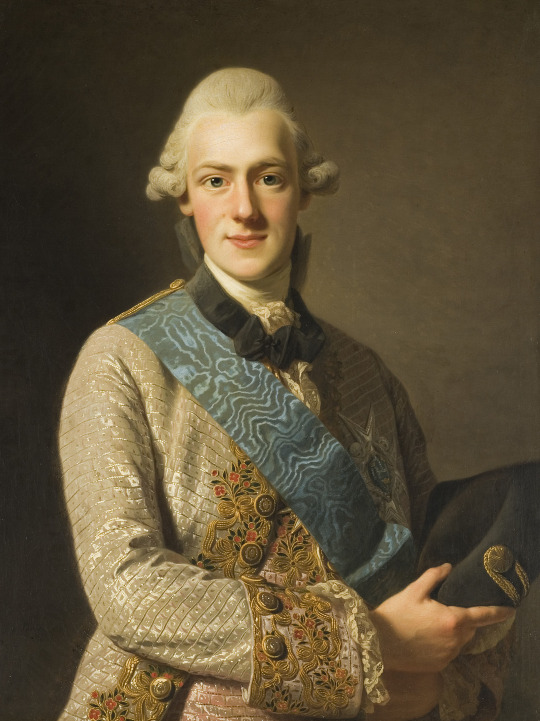
Prince Frederick Adolph of Sweden (1750-1803), Duke of Östergötland. By Alexander Rosslin.
Prince Fredrick Adolf is most known in history for his love life. He was never married, and the ceremonial duties of his consort were performed by his sister Sophia Albertina. He had several plans to marry, but none of them was realised.
#alexander rosslin#frederick adolf of sweden#duke of östergötland#konungariket sverige#kingdom of sweden#house of holstein gottorp
6 notes
·
View notes
Photo








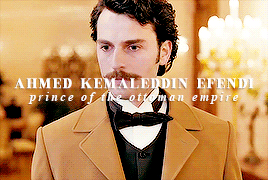

𝐭𝐨𝐩 𝟏𝟎 favourite men in history
#history#historyedit#selim ii#giacomo leopardi#murad v#murad iv#lucius sergius catilina#gustav ii adolf of sweden#frederick v of the palatinate#dante alighieri#sehzade ahmed kemaleddin#pope gregory vii#*mio#listen gregory vii was so mean i love him
146 notes
·
View notes
Text



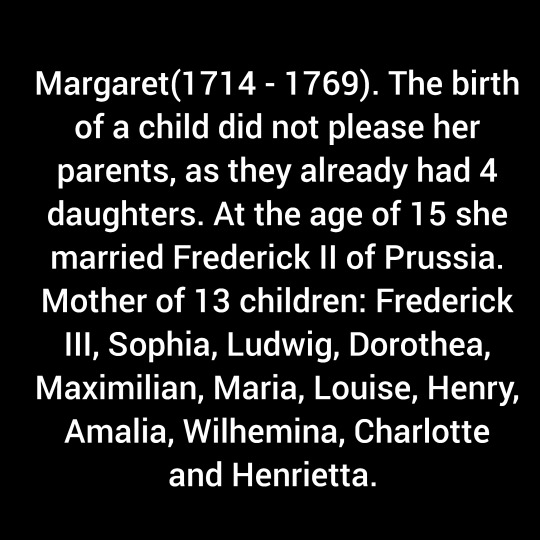



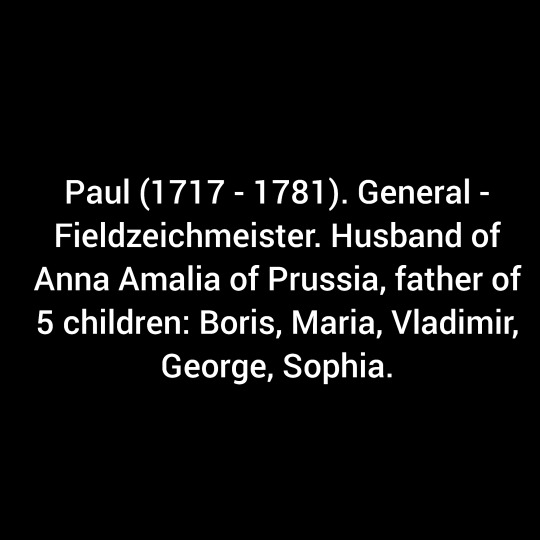
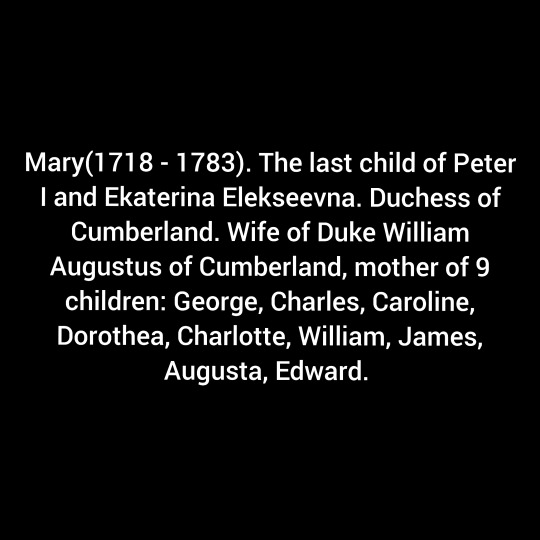
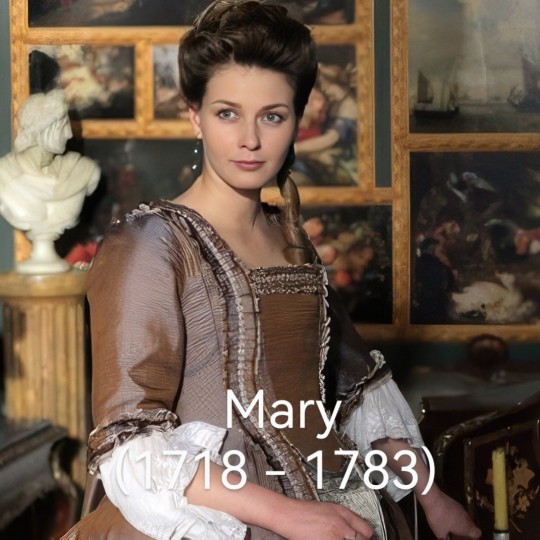
The Romanovs AU: Peter I(1672 - 1735)
Children by Evdokia Lopukhina(1669 - 1691). Died during childbirth.
Alexey(1690 - 1700). The eldest son and heir of Peter I and his first wife Evdokia Lopukhina. He had good mental abilities, but poor health. He died at the age of 10.
Alexander(1691). Died a few days after his birth.
Children by Catherine Alexeevna(1684 - 1742):
Catherine(1707 - 1773). The third child of Peter the Great, but the first child of his mother Catherine Alexeevna. Was named in honor of her mother. Queen of Sweden, wife of Adolf Frederick and mother of 10 children: Charles VIII, Sophia, Christian, Albertina, Fredericka, Christina, August, Amelia, Maria and Gustav.
Anna(1708 - 1728). Duchess - Consort of Holstein of Gottorp. Wife of Carl Friedrich of Holstein of Gottorp and mother of his son Carl Peter Ulrich. Died at the age of 20 from cold complications.
Elizabeth(1709 - 1762). She was the favorite daughter of Peter I, he affectionately called her Lizette. Queen of France, wife of Louis XV, mother of 8 children: Victoria, Jeanne, Louis XVI, Adelaide, Charles, Philippe, Antoine, Catherine.
Natalia(1713 - 1733). She was never married and had no children. Because of her fragile health, the tsarevna spent most of her life near her parents.
Margaret(1714 - 1769). The birth of a child did not please her parents, as they already had 4 daughters. At the age of 15 she married Frederick II of Prussia. Mother of 13 children: Frederick III, Sophia, Ludwig, Dorothea, Maximilian, Maria, Louise, Henry, Amalia, Wilhemina, Charlotte and Henrietta.
Peter II(1715 - 1777). Emperor of All the Russians. The long-awaited son of Peter I and Catherine Alexeevna. In honor of the birth of the heir, the emperor organized a great feast. The tsarevich had good health and high mental abilities. The future emperor was the pride of his parents. Peter II was popularly nicknamed the liberator, because he abolished serfdom. The husband of Caroline Elizabeth of England. Father of 7 children: Elena, Peter III, Ivan, Dmitry, Xenia, Alexandra, Nicholas.
Paul (1717 - 1781). General - Fieldzeichmeister. Husband of Anna Amalia of Prussia, father of 5 children: Boris, Mary, Vladimir, George, Sophia.
Mary(1718 - 1783). The last child of Peter I and Ekaterina Elekseevna. Duchess of Cumberland. Wife of Duke William Augustus of Cumberland, mother of 9 children: George, Charles, Caroline, Dorothea, Charlotte, William, James, Augusta, Edward.
Романовы AU: Пётр I (1672 - 1735)
Дети Евдокии Лопухиной(1669 - 1691). Умерла при родах.
Алексей(1690 - 1700). Старший сын и наследник Петра I и его первой жены Евдокии Лопухиной. У него были хорошие умственные способности, но плохое здоровье. Умер в 10 лет.
Александр(1691). Умер через несколько дней после рождения.
Дети Екатерины Елексеевны(1684 - 1742).
Екатерина(1707 - 1773). Третий ребёнок Петра I, но первый ребёнок у своей матери Екатерины Алексеевны. Была названа в честь своей матери. Королева Швеции, жена Адольфа Фредерика и мать 10 детей: Карл VIII, София, Кристиан, Альбертина, Фредерика, Кристина, Август, Амелия, Мария и Густав.
Анна(1708 - 1728). Герцогиня - консорт Гольштейн Готторпская. Жена Карла Фридриха Гольштейн Готторпского и мать его сына Карла Петера Ульриха. Умерла в 20 лет от простудных осложнений.
Елизавета(1709 - 1762). Была любимой дочерью Петра I, он ласково называл её Лизетт. Королева Франции, жена Людовика XV, мать 8 детей: Виктория, Жанна, Людовик XVI, Аделаида, Карл, Филипп, Антуан, Екатерина.
Наталья(1713 - 1733). Никогда не была замужем и не имела детей. Из за хрупкого здоровья царевна провела большую часть жизни рядом с родителями.
Маргарита(1714 - 1769). Рождение ребенка не обрадовало ее родителей, так как у них уже было 4 дочери. В 15 лет вышла замуж за Фридриха II Прусского. Мать 13 детей: Фридрих III, София, Людвиг, Доротея, Максимилиан, Мария, Луиза, Генрих, Амалия, Вильгемина, Шарлотта и Генриетта.
Пётр II(1715 - 1777). Император Всероссийский. Долгожданный сын Петра I и Екатерины Елексеевны. В честь рождения наследника император организовал большой праздник. У царевича было крепкое здоровье и высокие умственные способности. Будущий император был гордостью своих родителей. Петра II в народе прозвали освободителем, за то что отменил крепостное право. Муж Каролины Елизаветы английской. Отец 7 детей: Елена, Пётр III, Иван, Дмитрий, Ксения, Александра, Николай.
Павел(1717 - 1781). Генерал - фельдцейхмейстер. Муж Анны Амалии Прусской, отец 5 детей: Борис, Мария, Владимир, Георгий, София.
Мария(1718 - 1783). Последний ребёнок Петра I и Екатерины Елексеевны. Герцогиня Камберлендская. Жена герцога Уильяма Августа Камберледского, мать 9 детей: Георг, Чарльз, Каролина, Доротея, Шарлотта, Уильям, Джеймс, Августа, Эдуард.
Part 2
5 notes
·
View notes
Text
die of eating so many Semla buns
#sweden#King Adolf Frederick#submission#food and drink#disease and death#delicious! thats the way to go
85 notes
·
View notes